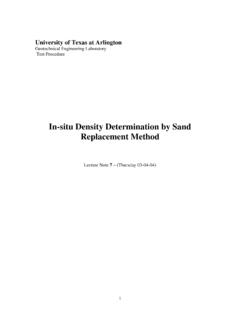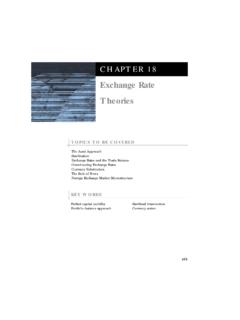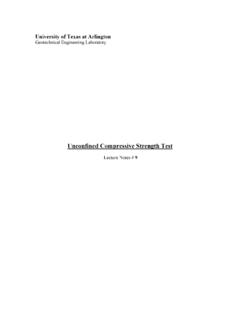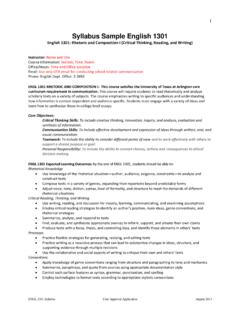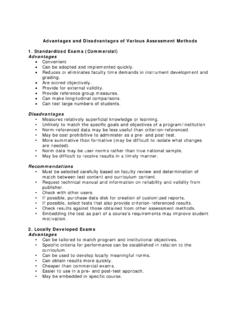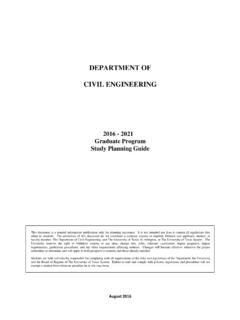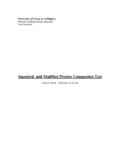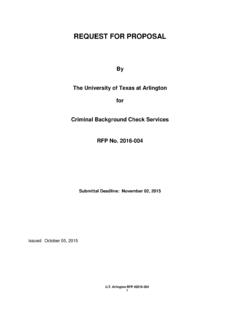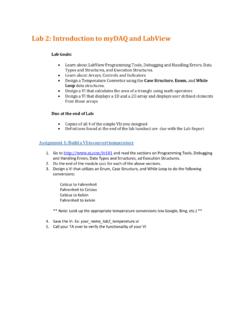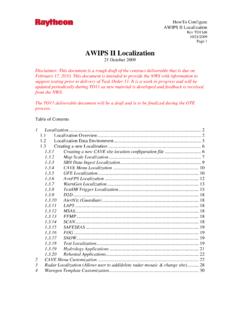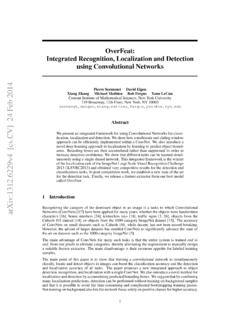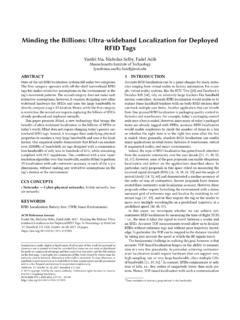Transcription of Ad hoc and Sensor Networks Chapter 9: Localization ...
1 Computer Networks GroupUniversit t PaderbornAd hoc and Sensor NetworksChapter 9: Localization & positioningHolger KarlSS 05Ad hoc & Sensor networs - Ch 9: Localization & positioning2 Goals of this Chapter Means for a node to determine its physical position (with respect to some coordinate system) or symbolic location Using the help of Anchor nodes that know their position Directly adjacent Over multiple hops Using different means to determine distances/angles locallySS 05Ad hoc & Sensor networs - Ch 9: Localization & positioning3 Overview Basic approaches Trilateration Multihop schemesSS 05Ad hoc & Sensor networs - Ch 9: Localization & positioning4 Localization & positioning Determine physical positionor logical location Coordinate system or symbolic reference Absolute or relative coordinates Options Centralized or distributed computation Scale (indoors, outdoors, global.)
2 Sources of information Metrics Accuracy (how close is an estimated position to the real position?) Precision (for repeated position determinations, how often is a given accuracy achieved?) Costs, energy consumption, ..SS 05Ad hoc & Sensor networs - Ch 9: Localization & positioning5 Main approaches (information sources) Proximity Exploit finite range of wireless communication : easy to determine location in a room with infrared room number announcements (Tri-/Multi-)laterationand angulation Use distance or angle estimates, simple geometry to compute position estimates Scene analysis Radio environment has characteristic signatures Can be measured beforehand, stored, compared with current situation LengthknownAngle 1 Angle 2(x = 2, y = 1)(x = 8, y = 2)(x = 5, y = 4)r1r2r3SS 05Ad hoc & Sensor networs - Ch 9.
3 Localization & positioning6 Estimating distances RSSI Received Signal Strength Indicator Send out signal of known strength, use received signal strength and path loss coefficient to estimate distance Problem: Highly error-prone process Shown: PDF for a fixed RSSID istanceDistanceSignal strengthPDFPDFSS 05Ad hoc & Sensor networs - Ch 9: Localization & positioning7 Estimating distances other means Time of arrival (ToA) Use time of transmission, propagation speed, time of arrival to compute distance Problem: Exact time synchronization Time Difference of Arrival (TDoA) Use two different signals with different propagation speeds Example: ultrasound and radio signal Propagation time of radio negligible compared to ultrasound Compute difference between arrival times to compute distance Problem: Calibration, expensive/energy-intensive hardwareSS 05Ad hoc & Sensor networs - Ch 9: Localization & positioning8 Determining angles Directional antennas On the node Mechanically rotating or electrically steerable On several access points Rotating at different offsets Time between beacons allows to compute angles 2 3 SS 05Ad hoc & Sensor networs - Ch 9: Localization & positioning9 Some range-free, single-hop Localization techniques Overlapping connectivity.
4 Position is estimated in the center of area where circles from which signal is heard/not heard overlap Approximate point in triangle Determine triangles of anchor nodes where node is inside, overlap them Check whether inside a given triangle move node or simulate movement by asking neighbors Only approximately correct??ABCDFGESS 05Ad hoc & Sensor networs - Ch 9: Localization & positioning10 Overview Basic approaches Trilateration Multihop schemesSS 05Ad hoc & Sensor networs - Ch 9: Localization & positioning11 Trilateration Assuming distances to three points with known location are exactly given Solve system of equations (Pythagoras!) (xi,yi) : coordinates of anchor pointi, ridistance to anchor i (xu, yu) : unknown coordinates of node Subtracting eq.
5 3 from 1 & 2: Rearranging terms gives a linear equation in (xu, yu)! SS 05Ad hoc & Sensor networs - Ch 9: Localization & positioning12 Trilateration as matrix equation Rewriting as a matrix equation: Example: (x1, y1) = (2,1), (x2, y2) = (5,4), (x3, y3) = (8,2), r1= , r2= 2, r3= 3!(xu,yu) = (5,2)SS 05Ad hoc & Sensor networs - Ch 9: Localization & positioning13 Trilateration with distance errors What if only distance estimation ri0= ri+ iavailable? Use multiple anchors, overdetermined system of equations Use (xu, yu) that minimize mean square error, , SS 05Ad hoc & Sensor networs - Ch 9: Localization & positioning14 Minimize mean square error Look at square of the of Euclidean norm expression (note that for all vectors v) Look at derivative with respect to x, set it equal to 0: Normal equation Has unique solution (if A has full rank), which gives desired minimal mean square error Essentially similar for angulation as well SS 05Ad hoc & Sensor networs - Ch 9: Localization & positioning15 Overview Basic approaches Trilateration Multihop schemesSS 05Ad hoc & Sensor networs - Ch 9.
6 Localization & positioning16 Multihop range estimation How to estimate range to a node to which no direct radio communication exists? No RSSI, TDoA, .. But: Multihop communication is possible Idea 1: Count number of hops, assume length of one hop is known (DV-Hop) Start by counting hops between anchors, divide known distance Idea 2: If range estimates between neighbors exist, use them to improve total length of route estimation in previous method (DV-Distance)XBACSS 05Ad hoc & Sensor networs - Ch 9: Localization & positioning17 Iterative multilateration Assume some nodes can hear at least three anchors (to perform triangulation), but not all Idea: let more and more nodes compute position estimates, spread position knowledge in the network Problem: Errors accumulate(2,10)(8,0)(18,20)(38,5)(?)
7 ,?)(?,?)(?,?)ABC(2,10)(8,0)(18,20)(38,5) (?,?)(?,?)(?,?)ABC(2,10)(8,0)(18,20)(38, 5)(?,?)(?,?)(?,?)ABC(2,10)(8,0)(18,20)(3 8,5)(?,?)(?,?)(12,14)ABC(2,10)(8,0)(18,2 0)(38,5)(?,?)(?,?)(12,14)ABC(2,10)(8,0)( 18,20)(38,5)(?,?)(?,?)(12,14)ABC(2,10)(8 ,0)(18,20)(38,5)(?,?)(30,12)(12,14)ABC(2 ,10)(8,0)(18,20)(38,5)(?,?)(30,12)(12,14 )ABC(2,10)(8,0)(18,20)(38,5)(?,?)(30,12) (12,14)ABC(2,10)(8,0)(18,20)(38,5)(22,2) (30,12)(12,14)ABC(2,10)(8,0)(18,20)(38,5 )(22,2)(30,12)(12,14)ABC(2,10)(8,0)(18,2 0)(38,5)(22,2)(30,12)(12,14)ABCI:II:III: IV:SS 05Ad hoc & Sensor networs - Ch 9: Localization & positioning18 Probabilistic position description Similar idea to previous one, but accept problem that position of nodes is only probabilistically known Represent this probability explicitly, use it to compute probabilities for further nodesSS 05Ad hoc & Sensor networs - Ch 9.
8 Localization & positioning19 Conclusions Determining location or position is a vitally important function in WSN, but fraught with many errors and shortcomings Range estimates often not sufficiently accurate Many anchors are needed for acceptable results Anchors might need external position sources (GPS) Multilateration problematic (convergence, accuracy)
